

| Home | For sale | Site map | Contact information | Guest book | Stielhandgranate 24 menu |
 Stielhandgranate
24 Stielhandgranate
24  |
|---|
|
Intro & history The history of the hand grenade dates all the way back to the middle-ages, but modern hand grenades didn't really catch on until the Russian-Japanese war in 1904-05. Reports about the use and effect of hand grenades during the battles in Port Arthur and Mukden were presented by the press in Europe as a totally new concept. This did in turn trigger the European armies to consider the use of hand grenades as a part of their arsenal. Several inventors applied for good, and not so good, patents for their inventions. 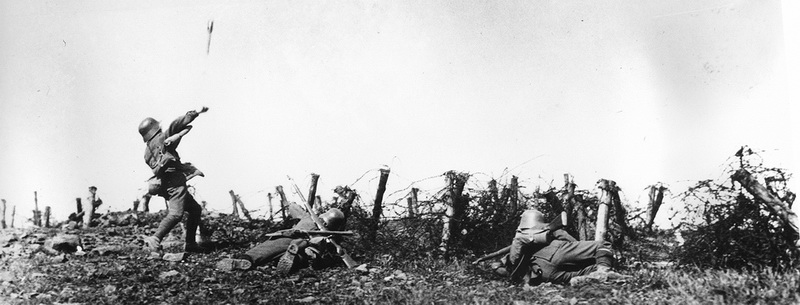 The modern hand grenade consisted of a container filled with explosives, a detonator and a fuse. The variations between the different models constructed and offered lay in the shape, ability to send out shrapnel and construction of the fuse, with or without safeties. The fuse could be either a time-delay or a impact fuse. Time-delay fuses were either of a mechanical clockwork construction or of the burning fuse type, with the burning fuse being the most used patent. The time-delay fuses seldom had any safeties beyond the transport safety. One of the big drawbacks of the time-delay fuse was the need to synchronize the time it took to throw the grenade the distance to the enemy and the actual burn time of the fuse itself. The first German hand grenade had a burn time of 7 seconds, enough to throw the grenade 50 meters. If the enemy was closer the thrower had to wait for the fuse to burn accordingly. Throwing the grenade too early meant that the enemy could grab it and return it. The burning fuse would be ignited either by a friction thread (like a matchstick) or with a spring actuated striker hitting a percussion cap. The internal delay pellet would ignite and burn for 3,5 to 7 seconds, depending on the model, before it set of the detonator. Impact fuses would detonate upon impact, but had a much higher fail rate. There was also the danger of inadvertently setting off the grenade prior to throwing it. A real danger when throwing them from narrow trenches was hitting the rear wall, with fatal consequences for the thrower. Some models incorporated advanced safeties, but these increased the failrate considerably. A Norwegian patent by the Engineer N.W. Aasen from 1913 incorporated a double wall canister with 56 embedded shrapnel and a impact fuse that was disarmed during flight. A cord was coiled up inside the grenade and held by the thrower. This would remove the safety pin when thrown beyond 10 meters. If the thrower forgot to hold on to the cord it would fail to detonate. A second model by the same inventor was later adapted by the German and Italian army. In the army of the Kaiser, hand grenades were considered a weapon only for Pioneers that would be attacking fortified positions. As a result, the German army entered the Great War with only 2 models of hand grenades, the ball-shaped hand grenade with a clockwork fuse (Kugelhandgranate Uhrwerkzünder) and the ball-shaped hand grenade with a burning fuse (Kugelhandgranate Brennzünder). The stocks of the prewar "Kugelhandgranate Uhrwerkzünder" were soon exhausted and it was not suited for wartime mass-production. 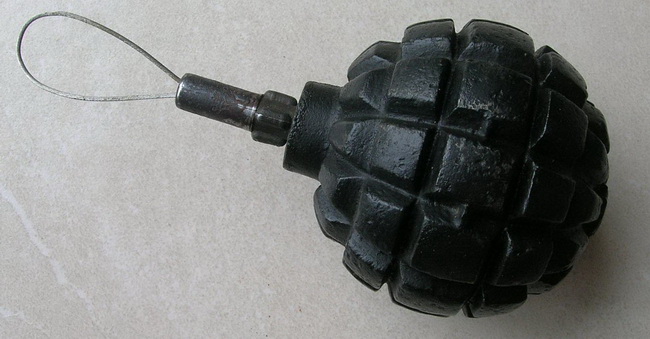 The "Kugelhandgranate Brennzünder" weighed in at 750 grams and was much too heavy for inexperienced throwers. In addition the thick iron casing gave off a deadly hail of shrapnel that was lethal up to 100 meters. This made it only usable for defense in the trenches. As a stop-gap measure the need for hand grenades was covered by trench-production. Explosives were attached to wooden boards and covered with different types of metal trash in order to act as shrapnel, and fitted with fuses. These resembled the later production Stielhandgranaten. The next production model was the discos shaped hand grenade with impact fuse and a safety that was deactivated during flight. This grenade was popular with the soldiers as it was easy to throw up to 40 meters and could be carried in numbers due to its small size and weight. The first experiences with hand grenades showed the need for an improvement to the functionality and handling qualities, the throwing range and the possibilities for the soldiers to carry more grenades into battle. In the spring of 1915 this resulted in the first Stiel handgranate. It consisted of a can filled with explosives mounted on a long handle that contained the fuse. The initial model was made "ready for use" at the factory, but this soon proved to be dangerous, as the detonator could be set off during transport and even under storage. Another problem was the fuse that would get moist, which in turn could result in malfunctioning. To prevent this from happening, the fuses and detonators would be shipped separated from the grenade heads, and were installed by the troops prior to use. In 1915 - 1916 a total of 5 different models of the Stielhandgranate saw service, with different models of safeties and fuses, including one with an impact fuse and and a spring activated safety handle, released during throwing.  A Stielhandgranate with impact fuse and the "Poppenberger spoon safety" 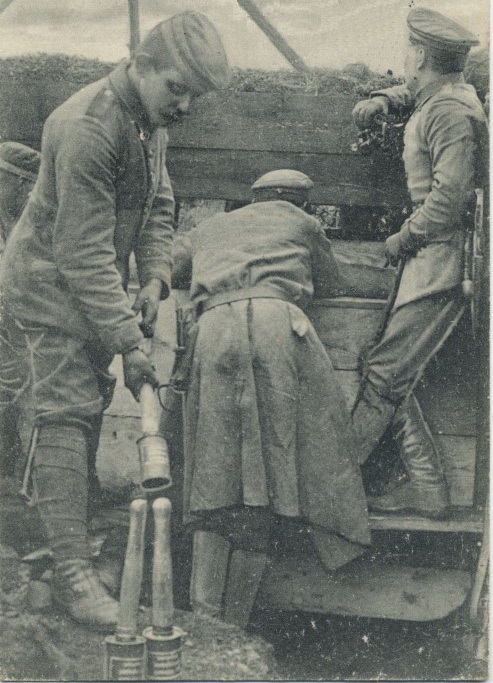 Picture courtesy of Nick Jeans In the trenches of the Great War. Stielhandgranate with external burning fuse are being prepared. By the end of 1916 only one model was left in production. It was designated "Stielhandgranate 15 mit Brennzünder 15". It was 380 mm long, the head was 60 mm in diameter and weighed 700 grams. It contained 250 grams of the explosive Ammonal and the fragments would go 15-20 meters. The handle was hollow and contained the fuse and a rope with a small ball at the end. The pull mechanism was sealed off with a star-shaped screw cap. The side of the can had a hook attachment that made it possible to carry the grenade suspended from the belt. There was also an improved igniter available designated the Brennzünder 16.  Stielhandgranate 15 mit Brennzünder 15 To complement the Stielhandgranate 15 a small smooth egg hand grenade was introduced in 1916. It only weighed 318 grams and could be thrown up to 60 meters. This hand grenade could be carried in large numbers in bread bags and pockets. An improved model, the Eierhandgranate 17, had a serrated belly belt that made it easier to handle and improved the fragmentation effect. The production followed the consumption of hand grenades during the Great war, and it reached its zenith during the winter months of 1916 -1917 with a monthly output of 9,000,000 grenades. By the end of the Great War the hand grenade had been fully accepted as a standard infantry weapon, with a very high consumption rate in the trench war. 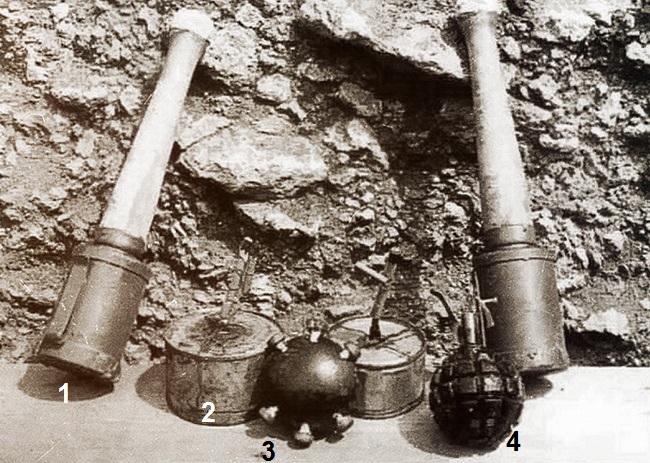 A photo from the trenches of the Great War. 1) Stielhandgranate with external burning fuse, note lack of safety cap to the end of the handle. 2) Trench-made hand grenade, made from recycled food cans. The fuse sits in the center of the lid, and must be lit with a flame. 3) Discos hand grenade, Modell 1913. 4) Kugelhandgranate Brennzünder 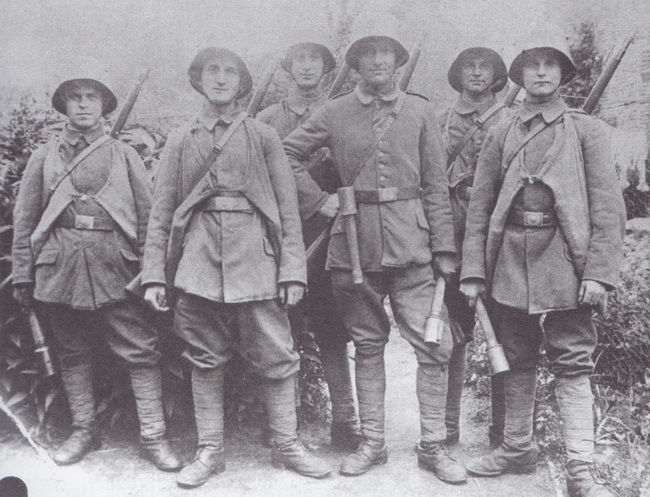 Unteroffizier Rudolf Schwenn (the tallest guy in the center) with men of his 1st Squad, 3rd Platoon, 12th Company of the 31st Infantry Regiment. The photo was taken in July 1917 during Stosstrupp training. Note the sandbags that have been connected together and slung around the neck to enable the soldiers to carry more Stielhandgranaten into the attack. The Treaty of Versailles of 28 June 1919 imposed huge restrictions on the losing armies, with some weapon systems forbidden altogether, like submarines and airplanes. The German army was restricted both in size, as well as in number of men and weapons. Due to this the remaining arsenals of hand grenades had to be limited and a total of 16,550,000 hand- and rifle grenades had to be destroyed. For continued service in the new Reichswehr only a limited number of Stielhandgranaten 15 mit Brennzünder 15 were allowed to be kept for further use and training. But these grenades had all been manufactured during the Great War for instant use, and were not suited for long storage. Combined with the wish to improve the Stielhandgranate 15, a new and improved model was ready in 1924-1925, the Stielhandgranate 24 with Brennzünder 24. As the production of the Stielhandgranate 24 started up, the old stocks of Stielhandgranate 15 were gradually used up. An order from the Reichswehrministeriums dated 27. January 1927 stated that all existing stocks of Stielhandgranate 15 should be collected and destroyed (blown up) on the units' training grounds by the end of March 1927. 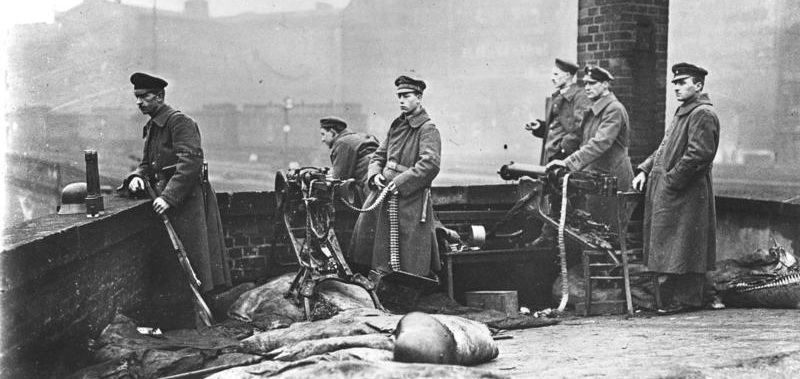 Freikorps soldiers on guard in Berlin in 1919 during the fighting against the communist Spartans. Note the Stielhandgranaten 15 on the left. Go back to the Stielhandgranate 24 menu |
| Home | For sale | Site map | Contact information | Guest book | Stielhandgranate 24 menu |